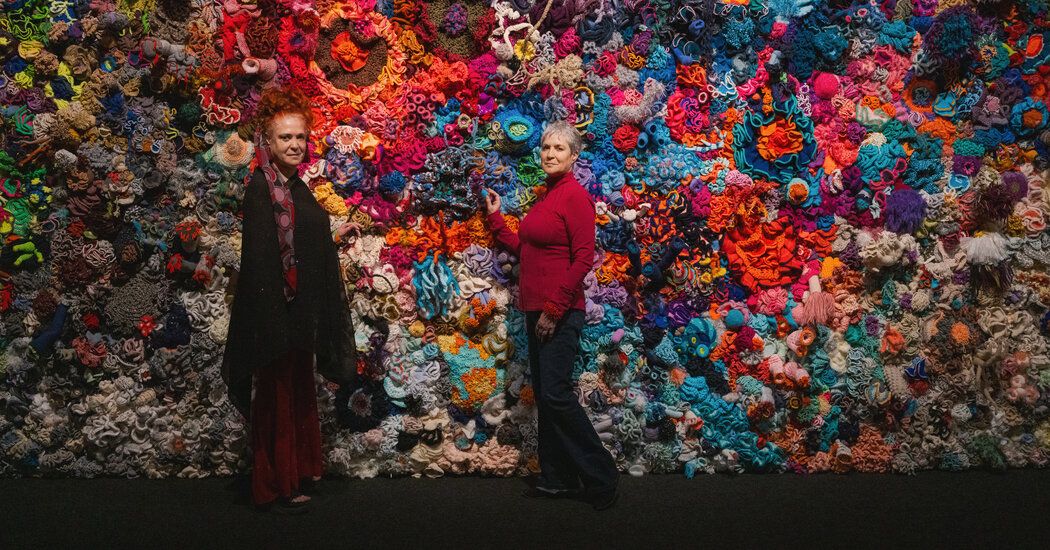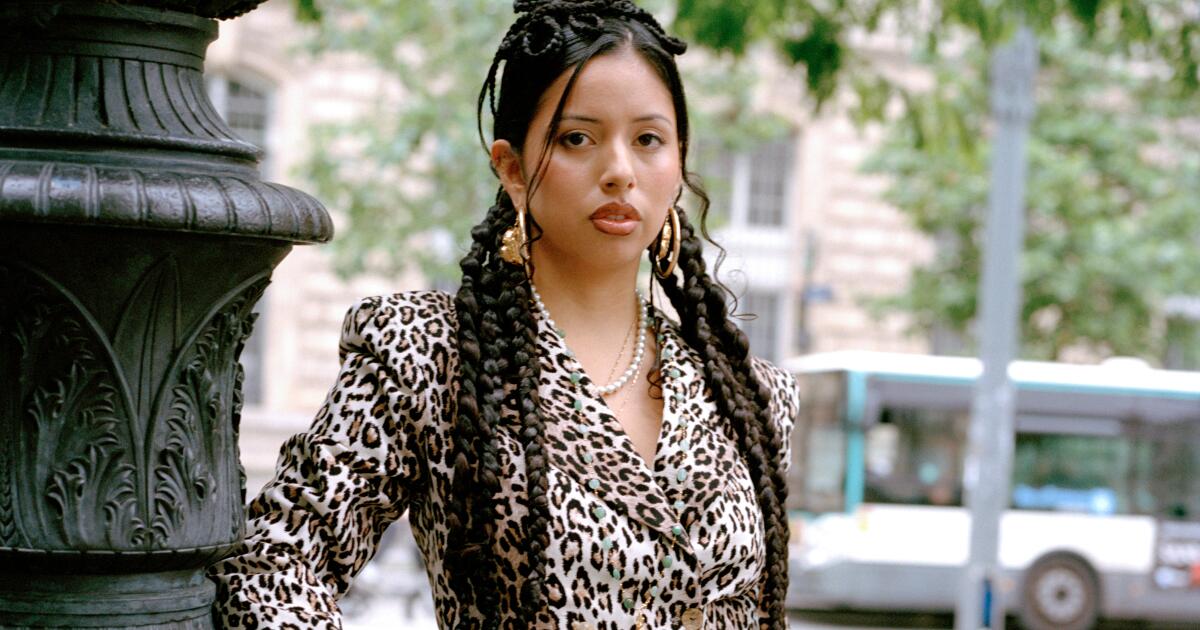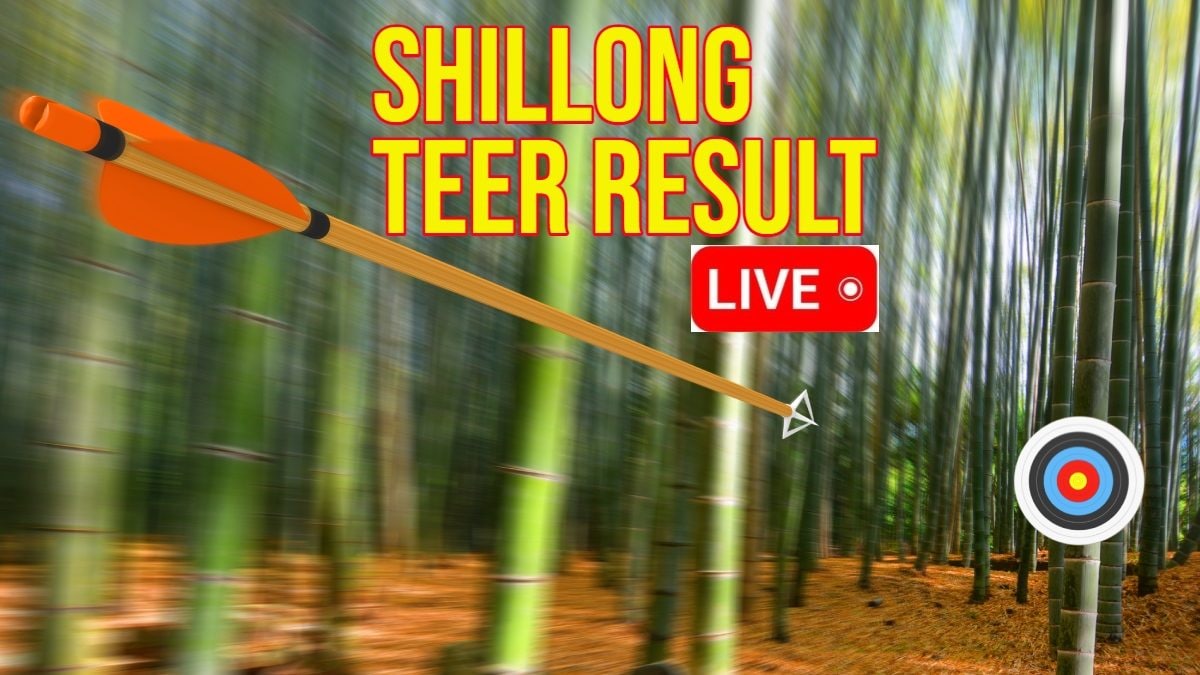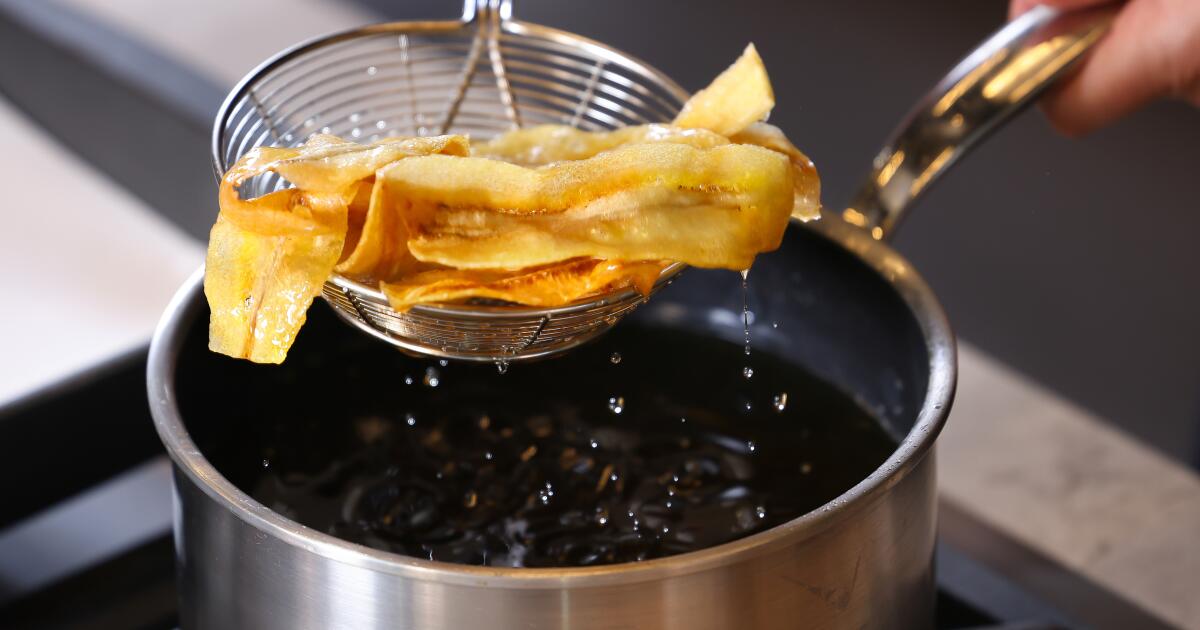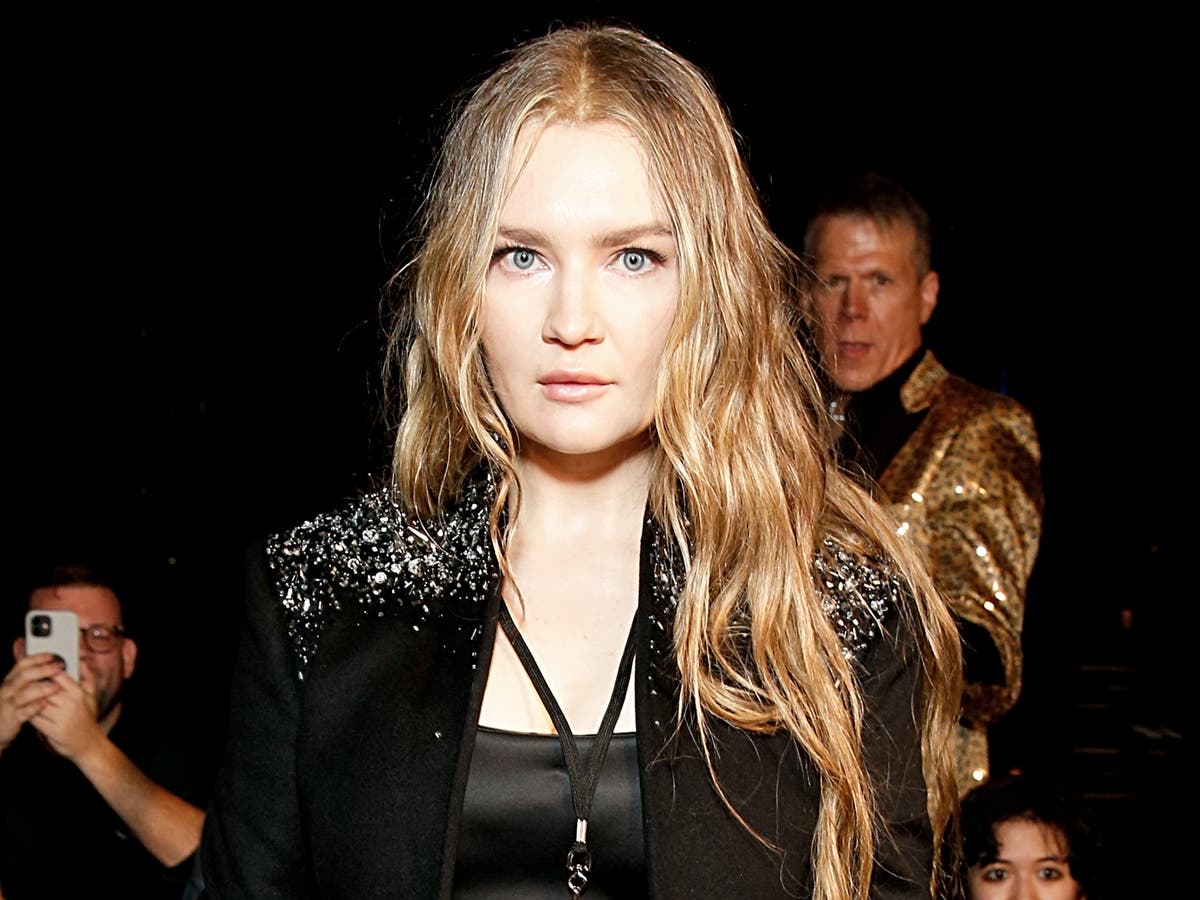Every year, after the full moons of late October and November, Australia's Great Barrier Reef begins its annual spawning: first the coastal coral species, where the waters are warmer, then the offshore corals, the event major. Last year, this natural spectacle coincided with the woolly spread of two new colonies of the Crochet coral reef, a long-standing collaborative work of art between crafts and science that now inhabits the Schlossmuseum in Linz, Austria, and the Museum of Pittsburgh Carnegie Art.
To date, almost 25,000 crocheters (“reefers”) have created a global archipelago of more than 50 reefs, a praise and plea in favor of these ecosystems, the tropical forests of the sea, which are threatened by climate change. The project also explores mathematical themes, as many living reef organisms biologically approximate the peculiar curvature of hyperbolic geometry.
Within the realm of two dimensions, geometry is concerned with the properties of points, lines, figures and surfaces: the Euclidean plane is flat and therefore shows zero curvature. In contrast, the surface of a sphere shows a constant positive curvature; At all points, the surface bends inward, towards itself. And a hyperbolic plane exhibits constant negative curvature; at all points, the surface curves away from itself. Reef life thrives on hyperbolism, so to speak; The curved structure of the coral surface maximizes nutrient intake and the nudibranchs propel themselves through the water with frilled eyelashes.
In works of art, marine morphologies are modeled (crocheted) with crazy verisimilitude. A little like Monet's water lilies, crochet corals are abstract representations of nature, said Christine Wertheim, an artist and writer now retired from the California Institute of the Arts. Dr. Wertheim is the driving artistic force behind the project, which she created with Margaret Wertheim, her twin sister, a science writer who is in charge of the scientific and mathematical components, as well as management. The Wertheims, Australians who live together in Los Angeles, created the mother reef in their living room many moons ago, in 2005.
Crochet Coral Reef exhibitions typically have two main components: The Wertheims provide an anchor of sorts with works from their collection that they have knitted over the years. They also incorporate pieces from select qualified international collaborators. One is a “bleached reef,” reminiscent of corals stressed by rising ocean temperatures; another, a “coral forest” made of thread and plastic, laments the debris that pollutes reef systems.
Then, in response to an open call, volunteers from all over weave a parade of individual specimens that crowd into a “satellite reef,” organized by a local curatorial team with guidance from the Wertheims. The Wertheims compare this hive mind to a friendly version of the Borg from “Star Trek: Next Generation.” All contributors are accredited.
The largest satellite reef yet merged in 2022 at the Frieder Burda Museum in Baden-Baden, Germany, with about 40,000 pieces of coral from about 4,000 contributors. The Wertheims call it the Sistine Chapel of crochet reefs (documented in an eye-catching exhibition catalogue). But the exhibition at the Schlossmuseum in Linz, dedicated to natural sciences as well as art and culture, is reminiscent of the work of the painter Giuseppe Arcimboldo, whose collage portraits based on representations of fruits, vegetables and flowers are “fantastically heterogeneous, also very funny and smart,” Ms. Wertheim said.
The Linz satellite reef brings together around 30,000 pieces from 2,000 weavers. The disparate parts draw colorful inspiration from traditional Austrian “craftsmanship,” as the exhibition text puts it, and there is a huge, glowing coral wall that nods to artist Gustav Klimt. However, in the Wertheims' opinion, the choral crochet project is proof that it is not always solitary geniuses who create great works of art, but also communities. In the art world, that's a radical idea, they noted, but in science, large collaborative projects and papers with thousands of authors are unprecedented.
Primordial deception
Scientifically, the Linz exhibition has a special symbolism since, as the narrative explains, the region was previously occupied by an “ancient primordial sea, full of corals whose remains can still be found in the basins and Alps of Upper Austria.” .
The mathematical dimension of the story intersects (from afar) with the research of applied mathematician Shankar Venkataramani and his students at the University of Arizona. They use idealized models to study hyperbolic surfaces in nature. “It's everywhere around us,” Dr. Venkataramani said; consider the ubiquity of kale. “The question is: why is everything around us?” The evolutionary benefit of textbooks, he said, is that they help optimize processes like circulation and nutrient absorption. Studies by his research group show additional advantages, such as providing a structural “sweet spot,” making organisms neither too rigid nor too flexible, and allowing them to “move and change shape with a small energy budget.”
When Margaret Wertheim, who studied mathematics, physics and computer science in college, learned hyperbolic geometry, she found it “a little tricky.” She took the principles more by faith than by understanding. However, through crochet patterns, she said, “you really learn in a very deep way what a hyperbolic structure is, and in a way that I think is very pedagogical.”
Feeling the decorations
That the hyperbolic plane could be created with a crochet hook became evident only a quarter of a century ago. Daina Taimina, a now-retired mathematician from Cornell University, made this discovery while she was preparing a geometry course. “I needed to feel it,” Dr. Taimina said. Research with the Wertheims in the early and mid-2000s planted the seed for their coral reef project (and a book chapter, “A Field Guide to Hyperbolic Space”) and for the workshops and outreach performances of Dr. Taimina (and a book of her own, “Crochet Adventures with Hyperbolic Planes”).
Further back, in 1868, the Italian mathematician Eugenio Beltrami constructed a parchment model of the hyperbolic plane and rolled it into a negatively curved surface called a pseudosphere (as they do). A century later, mathematician William Thurston independently had a similar idea, using paper and tape.
Dr. Taimina found a crumbled paper version in 1997 at a workshop taught by David Henderson, a Cornell mathematician, and her partner. Dr. Henderson had learned the modeling technique from Dr. Thurston. At the event, Dr. Taimina set out to build something more flexible and durable for her course. When she tried knitting, the result was too loose and unwieldy. Crochet turned out to be the perfect medium. Dr. Taimina devised a simple algorithm: increase the number of points by a constant ratio N+1. For example, say N=6: knit six stitches and, in the seventh stitch, increase by knitting two stitches in one; repeat, row after row.
“You can experiment with different ratios, but not in the same model,” he warned in an article for “The Mathematical Intelligencer” that he wrote with Dr. Henderson. “You will get a hyperbolic plane only if you increase the number of points by the same proportion all the time.”
Dr. Taimina also joined Dr. Henderson, who died in 2018, as co-author of revised editions of his book “Experiencing Geometry,” in which he described his belief “that mathematics is a natural and profound part of human experience and that experiences of meaning in mathematics are accessible to all.
The Wertheims took a similar vision with their Institute for Figuring, a nonprofit where projects are motivated by the belief that people can play with and aesthetically appreciate (and therefore gain an understanding of) mathematical ideas.
With her scientific background, Margaret's instinct had been to follow Dr. Taimina's algorithm to the letter. But Christine's artistic sensibility was to break the rules and go crazy. For example, she knits a few rows, increases every third stitch and then switches to every fifth stitch and then every second stitch; The result is not perfectly hyperbolic, because the piece does not have a regular curvature.
For the Wertheims, embracing that irregular flourish was the moment their crochet reef project was born: erratic algorithms spawned a rampant taxonomy, a woolly seascape of creatures that even more closely emulated the geometrically aberrant curvatures of their biological counterparts. the real life.
Patterns of change
Another incarnation of crochet-coral emerged recently from a pool of creativity organized by the Carnegie Museum of Art in Pittsburgh, a city known for its three rivers: the Allegheny and Monongahela rivers converge to form the Ohio, which flows into the Mississippi, which flows into toward the Gulf of Mexico, where coral spawns after the full moons of July and August. This show, organized by Alyssa Velázquez, curatorial assistant for decorative arts and design, features just one satellite reef made by 281 community crocheters.
Velázquez noted that the Wertheims' project is inspired by the fiber art movement, driven mostly by women, including Sheila Hicks, Tau Lewis and Marie Watt, and then democratizes it. As the women (mostly) gathered and wove loops of yarn, Velázquez noted the threads of the conversations: memories of time spent on local waterways, recycling habits, the opportunity to knit something other than baby booties. In that sense, the company represents “the creative potential for environmental dialogue and new ecological behaviors,” he said, invoking imaginative but concrete patterns of change.

